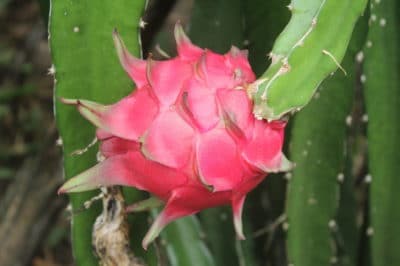What is Dragon Fruit?
Dragon fruit (Hylocereus undatus) is an unusual member of the cactus family. First, it is actually a vining aerial climber. Second, it has very large flowers, but they only last one night before wilting. Third, it can bloom and produce fruit five or six times a year. The fruit is ripe when brightly colored and slightly soft when squeezed.
Where is Dragon Fruit Grown?
Dragon fruit is thought to be native to Mexico. Europeans probably took the plants to other areas of Central America. Today they are also grown in China, Vietnam, Thailand, Israel, Australia, Cyprus and the Canary Islands. The plant does well in USDA Zones 9 to 11, although it is sensitive to frost. Outdoors, it will grow best in Zones 10 and 11.
Are There Different Kinds of Dragon Fruit?
Sweet pitahayas – a common name for dragon fruit – come in three types. All have slightly leafy, leathery skin. They include:
- Pitaya blanca or white-fleshed pitahaya (Hylocereus undatus) – most common kind; pink skin, white flesh.
- Pitaya roja or red-fleshed pitahaya (Hylocereus costaricensis) – red skin and flesh.
- Pitaya amarilla or yellow pitahaya (Hylocereus megalanthus) – yellow skin, white flesh.
What Kind of Soil Does Dragon Fruit Need?
Like most cacti, dragon fruit needs good drainage. A commercial cactus mix is a good choice for container-grown plants. In the garden, mix 2 parts garden soil with one part compost and one part aged manure. You can also use commercial potting soil with additional perlite or vermiculite. Test the soil – dragon fruit likes a pH between 6 and 7.
Does Dragon Fruit Need a Trellis?
Dragon fruit isn’t a vine; it won’t twine up a trellis. However, it does need some support or it will flop on the ground or over the side of a pot. Mature plants can reach a height of 25 feet and weigh well over 100 pounds. A wooden arbor or similar sturdy structure would be a good choice. You’ll need to tie the plant to the support system.
How Do I Grow Dragon Fruit in the Garden?
If you live in the right climate, dragon fruit can be grown outdoors. Grow in a raised bed or prepare the soil properly to ensure excellent drainage. It will do well in full sun or with some afternoon shade. The plants are sensitive to cold temperatures and intolerant of frost. Do not over-water – this is basically a desert plant and susceptible to root rot.
Can I Grow Dragon Fruit in Containers?
Dragon fruit will grow in containers, but make sure the container is a big one. If you live in a marginal heat zone, you may want to move it indoors for frost protection – place it on a dolly with casters for easy movement. Unglazed clay pots with multiple drainage holes are a good choice as they help prevent water from sitting in the soil.
How Do I Propagate Dragon Fruit?
Although dragon fruit can be grown from seed, the quality of both flowers and fruit is diminished. Vegetative propagation is a better choice. Cut a piece of stem at a 45 degree angle that is six to 15 inches long after the plant has fruited. Dip in liquid, then powdered fungicide. Dry in cool shade for seven days. Dip in rooting hormone; plant 1 ½ to 2 inches deep.
Can I Eat the Fruit?
Dragon fruit is edible. The center of the fruit is composed of a jelly-like red or white pulp with multiple small black edible seeds, similar to a kiwi fruit. The easiest way to get at the pulp is to cut the fruit in half and scoop out the pulp with a spoon. It can be used in fruit salad and drinks or eaten plain. The tough outer rind is discarded.
What About Pests and Diseases?
Over-watering is the biggest problem with dragon fruit and can cause root rot or excessive flower drop. It can also make fruits split. Rot can result from bacterial or fungal infection from various species. Birds may damage the fruit by pecking at the outer rind to get to the sweet pulp. Pets may break branches if allowed near the trellis.
